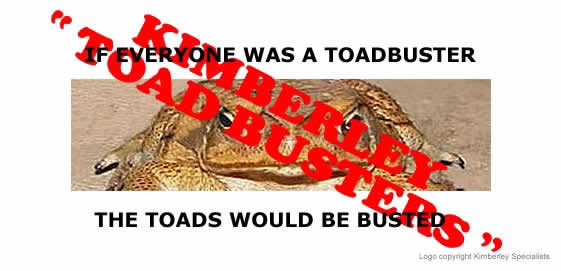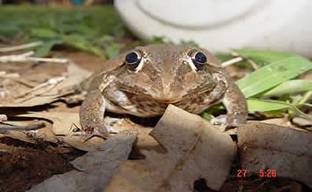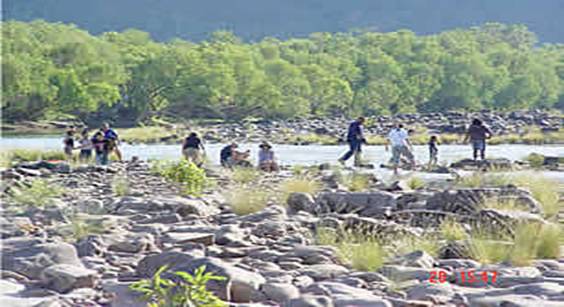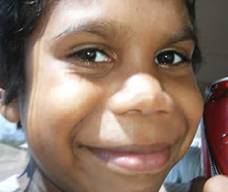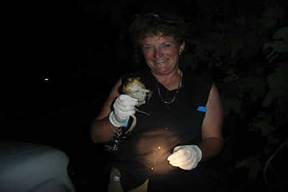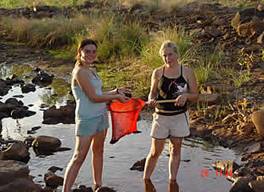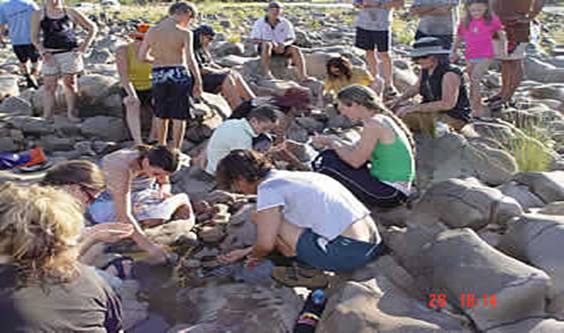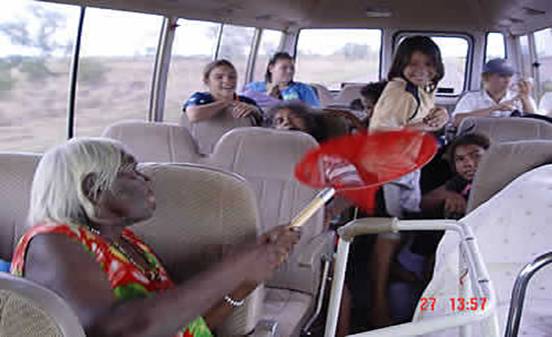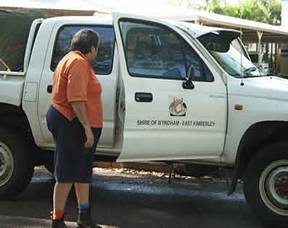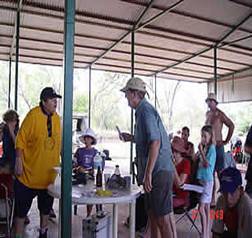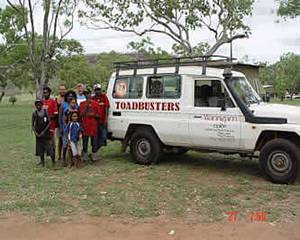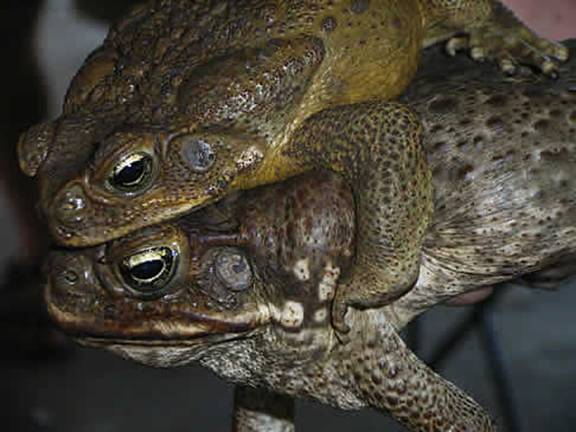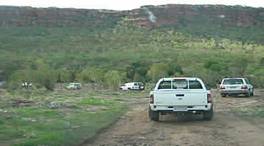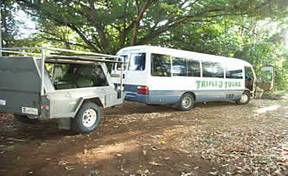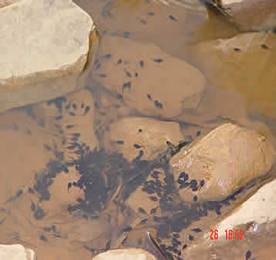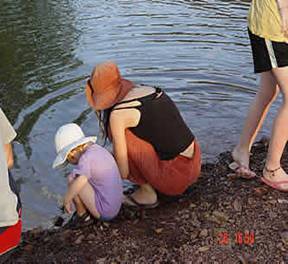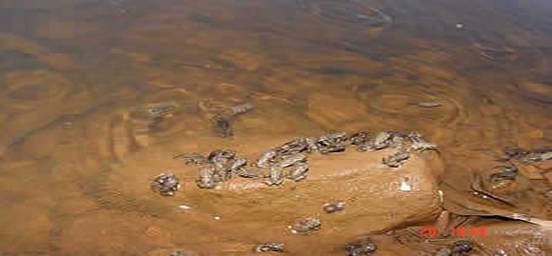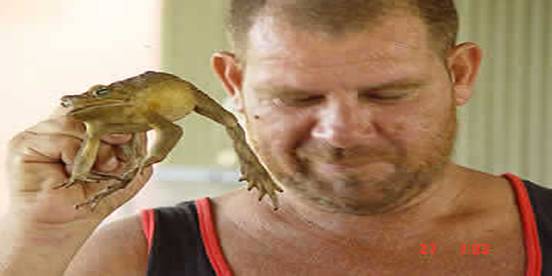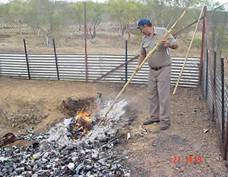A heartfelt cry from the Kununurra Community to the Nation. We will Stop the Cane Toads getting into WA! |
 |
 |
 |
 |
 |
|---|
KIMBERLEY SPECIALISTS Volunteer CANE TOAD Training & Toad Busting NEWSLETTER No.6
WWW.CANE TOADS.COM.AU The Cane Toad is a Key Threatening Process to the Australian Nation. Federal Government 12 April 2005 IF EVERYONE WAS A TOADBUSTER www.kimberleyspecialists.com.au www.kimberleyspecialists@westnet.com.au By Lee Scott-Virtue Contents: IF EVERYONE BECAME A TOAD BUSTER. THE TOADS WOULD BE BUSTED. An Introduction to the Kimberley Toad Busters Kimberley Toad Busting Achievements in a nutshell! Toad Busting on the weekends of the 19 th and 20 th. And the 26 th & 27 th (Tourism training exercise). How do we dispose of the cane toads in their various stages of Life? Thank You! What’s Next? Report by Jane Harman. Report by Paul Sharpe. |
An Introduction to the Kimberley Toad Busters. I apologise for the lateness of this Newsletter. It does mean that I now have to fit in an enormous amount of information. Our Kimberley Cane Toad Volunteer Group is Toad Busting in several areas on a consistent basis as well as tackling new areas as the reports of unexpected cane toad incursions come in. Combined with the ever successful training sessions, the data base is almost impossible to keep up with. As ‘ownership’ of areas is claimed by various Toad Buster leaders and their groups, they will begin to send in reports of their own which will make my job easier. We anticipate that most of the identified cane toad problem area’s along the ‘front line’ will be allocated to various Toad Buster Leaders and each Team Leader will organise the weekend (or weekly) cane toad busting exercises and write up their own reports for the Kimberley Toad Busting Newsletter and for updates to the Kimberley Specialists Community website. Kimberley Specialists with the assistance of Sarah Brett (Kimberley Wildlife Rescue) will continue to manage the broader field strategy, liaise with CALM, Aboriginal and CDEP Coordinators, pastoralists and other agencies, collate the field data, ensure each team has a field manual, and manage and sign in and out field equipment required by each team. Jane and Greg Harman will also assist with all of this when they return from their holidays in mid January. IF EVERYONE BECAME A TOAD BUSTER. THE TOADS WOULD BE BUSTED. It is so difficult to produce a Newsletter that embraces all that has actually happened with our Kimberley ‘Toad Busters. The energy and focus of this East Kimberley Community over the past few months has been all encapsulating. Kimberley Specialists, Dean and I, and all those who have contributed towards the setting up and training of the Kimberley Toad Busters (particularly Sarah Brett from Kimberley Wildlife Rescue and Sandra Boulter, Environmental Lawyer and Aboriginal Leaders Ju Ju and Georgina Wilson and Annie Wilson) cannot believe the energy that has emanated from this community. We began a simple program (with the help of Graeme Sawyer from Frogwatch) to train and put together a volunteer Cane Toad ‘fighting force’ to help to stop the cane toad from crossing the WA border into the Kimberley . The first cane toad training program alerted us that those participating were in for the long’ haul’. After 5 major Cane Toad Training exercises and several toad busting exercises later we now have over 70 Toad Busting Leaders and a volunteer force that now represents well over 300 people. What is even better is the acknowledgement that all of us who participate in the cane toad busting exercises actually have fun
We have also set in place a toad busting strategy that will take us well into the wet season. The results from the end of dry 2005 season toad busting strategy have also enabled us to put in place a field strategy for the 2006 dry season. Reports on the results of these weekly toad busting exercises will continue to be published on the Community Website www.canetoads.com.au and in regular Newsletters. Within the Community energy, CDEP coordinators such as Ronnie Atkins and Garry Elford and Richard Beech have managed to put in place one of the first potential CDEP projects that might actually work with Aboriginal Communities. Ronnie Atkins commented. “ This program has a lot of positive outcomes besides helping remove the cane toads, it has a proved invaluable in the connection to the land for the Community people, the working together with non Indigenous and the physical and well being of Community people that wish to get involved, I had a comment from more than one young Indigenous person that they thought it was great that we all work together on this project.
Toad Busting has now been recognised within the CDEP Program as a paid CDEP work project. A second project, organised by Chris Spur from TAFE has now put in place a cane toad trap making program. Aboriginal Communities registered under the CDEP cane toad busting program have registered for the TAFE cane toad trap making courses. The energy emanating from this community in our efforts to stop the cane toad from crossing into Western Australia is exciting and energizing. It is incredible to see the commitment and dedication within our Kimberley Toad Busting team. There are no cultural boundaries. Black and white, old and young all work together busting toads, learning about nature and just generally having fun. We also collate an enormous amount of base line data in the hope that this will assist in future scientific research
.KIMBERLEY TOAD BUSTING ACHIEVEMENTS IN A NUTSHELL!
Toad Busting on the weekend of the 19 th and 20 th! And the 26 th & 27 th. November. The results from the 19 th/20th weekend’s Volunteer’s Toad Busting were next to phenomenal. Three teams led by Del Collins, Dean Goodgame, Bruce Russell, and Aboriginal Leaders and Toad Busting Coordinators, Ju Ju and Georgina Wilson. Mature toads, eggs and tadpoles were busted and recorded in several areas. A total of 29 kgs of toads were busted amounting to a total number of 129 mature males and females. 71 of these were very gravid females. We estimate that at the worst end of the scale that we stopped the laying of eggs at around 330,000 eggs. Artemis International Documentary film maker, Renee Webster joined the crew for the 19 th/20 th weekend Toad Busting and witnessed the community passion and the hard work that goes into these toad busting exercises. Renee was essentially reconnoitering for her camera crew for the weekend of the 26th/27rh. Like previous member of her film crew, Renee has become a committed Kimberley Toad Buster.
The 19 th and 20 th Nov. also saw a second team Toad Bust the Fitzroy Station area south of Fitzroy Community. Kimberley Toad busters Dave Woods, Chris Shaw and team members joined Paul Sharpe from Darwin to see if they could identify just how far south of the Fitzroy Community the cane toad incursions had extended. Several waterholes were found to contain toads. These were busted; however the main purpose of this exercise was to identify how far the cane toads had traveled and to reconnoiter the area for future toad busts. Paul was also able to examine some of the water holes on Bradshaw Station. Our Kimberley Toad Busting team had been alerted some months back to the presence of cane toads on Bradshaw from scientists and some of the traditional owners who had recently visited some of their sacred water holes on Bradshaw. Our Toad Busting team provided Paul Sharpe with this information and introduced him to Elaine Watts who facilitated the meeting with Gerry Jones. Paul was able to confirm that there were indeed large numbers of cane toads and tadpole activity. A second excursion into this area was undertaken again on the weekend of the 26 th and 27 th led by Kimberley Toad Busters Dave Woods and John Cugley and was able to confirm that the toads extended at least 45 km south of Fitzroy Station Community. A report from Paul Sharpe has been added onto the end of this Newsletter outlining his observations and proposed combined barrier, trapping and toad busting in this area.
The Kimberley Toad Busters have not observed any tadpole populations in the waterholes they have been regularly busting. We are for the moment accepting that this is a sign that we are managing to get to the breeders before they lay their eggs. This is not the case with some of the area’s they have not been able to access due to NT National Parks & Wildlife Permit requirement and these areas are now showing significant signs of cane toad eggs, tadpole and metamorph inclusions. This would indicate that had the Kimberley Toad Busting volunteer group been able to work in some of the NT National Park designated they would have been able to ‘knock’ the breeding females on the head. The need for volunteer groups to clear water systems of cane toad eggs, tadpoles and toadlets is even more critical at the moment. As is the need to work with CALM on ground strategies. The bureaucratic red tape that is stopping volunteer groups from working in NT National Park areas needs to be addressed urgently. Research into the NT Legislation and letters to the NT Minister addressing some of the legislative issues has been drafted by our very own volunteer lawyer Sandy Boulter. The weekend Toad Bust and Tourism Training Exercise. Thanks to Graeme Sawyer and Frogwatch our Kimberley Toad Busting Volunteer Group were able to work in some of the badly infested cane toad tadpole and metamorph impacted creek lines last weekend (26 th & 27 th). I have to say that the Cane Toad Training and Toad Busting weekend of the 26 th and 27 th and the 5 th major training exercise for the Kimberley Toad Busters was one of the most successful yet. The turnout was amazing. Around 80 individuals, families with their children and members of the Tourism Industry arrived at the Victoria River Roadhouse to both train and bust toads for the weekend. A film crew from Artemis International Film Company followed our cane toad busting activities over the weekend and appeared rather overwhelmed, by the incredible amount of energy and enthusiasm that emanated from everyone present. They were certainly kept on their toes trying to follow all the various toad busting activities that had been set for the weekend. Jane Harmon and the infamous ‘Hairy Dog’ absolutely surpassed themselves in the logistical organisation of the educational side to the training. Jane had also organised a culinary BBQ delight, even including marinated and barbequed Barra wings for the evening meal and it was agreed by everyone that this was one of the best educational ‘and social’ training exercises held yet!
Graeme Sawyer from Frogwatch, (and almost certainly one of the most knowledgeable Cane Toad experts in Australia ), once again volunteered his time and energy towards educating our Kimberley Toad Busters. It is this generous ongoing educational input from Graeme that has not only contributed enormously towards the success of our Kimberley Toad Busting Training exercises, but I also feel has helped us to produce a Community volunteer force with the growing expertise to singularly address the real issues of stopping the cane toad from crossing into the Kimberley. Peter Stubbs from the SWEK also joined our toad busting team over the weekend and provided a short address of encouragement, outlining the Shires commitment and support for the Kimberley Toad Busting volunteer efforts. The SWEK and Triple J once again provided vehicles to get some of our toad Buster volunteers to the cane toad front. Recent rains meant that cane toad tadpole and toadlet activity had increased, and although we had been expecting to see this increase in activity it came as a shock to see just what density in numbers we actually had to deal with. We were able to hit several areas at once which resulted in the biggest toad bust yet! Thousands of cane toad tadpole’s and toadlets were removed from various creek and other aquatic systems. It is impossible to count just how many as the process is more one of ‘scooping’ them out with fine nets or by hand, however I think I can safely say we probably managed to pull out tens of thousands. 211 large cane toads were busted and sent to heaven. 118 of these were female and we estimate that our toad busting team prevented the laying of around 30,000,000 eggs. Once you calculate the tens of thousands of tadpoles that were possibly female the results of our toad busting weekend was pretty spectacular. The bad news is The evidence of a second generation of cane toads massing on the other side of the Victoria Bridge . Culverts along a stretch of around 10 km were search by Del Collins and Georgina Wilson. “Each culvert housed dozens of juvenile cane toads” commented Del Collins. Our star cane toad busters were the dozens of children, both Aboriginal and non-Aboriginal, that busted toads and pulled out tadpoles for hours on end. I really would like to encourage more families to participate in these toad busting training exercises. As well as helping to stop the cane toad from crossing into the Kimberley they are a lot of fun. They also help to provide our children with a clearer understanding of nature and some of the broader environmental issues that are confronting the survival of our native wildlife. How do we dispose of the cane toads in their various stages of Life? Tadpole Eggs: With the help of Frogwatch Graeme Sawyer it has been decided that the best method for our volunteers is to actually ‘pull’ the strings of cane toad eggs out of the water by hand and throw them up onto the banks. Cane Toad Tadpoles: Scooping out by hand or using f ine meshed hand held long handled butterfly nets appear to be the best methods we have at present for disposing the cane toad tadpoles. Chris and Tina De Meo (the brains behind this idea) suggested a petrol driven Leaf Blower may be a very good method of disposing of the tadpoles and we will be trialing this over the next several Toad Busting weekends. We will also be trialing a wet and dry Vacuum Cleaner. Early trials of scooping the tadpoles out of the water up onto the banks or onto hot rocks indicated the tadpoles only survived for a few seconds. If either, or both the Leaf Blower and the Vacuum Cleaner work our Toad Busting teams should be able to dispose of thousands of tadpoles in minutes.
Toadlets (metamorphs). Fine meshed hand held nets do work but it is a slow and laborious method. Graeme Sawyer and his team experimented with a small hand dug pit trap during last weekends exercise with a fair degree of success. Our Toad Busting team will continue to experiment with this method over the next several weeks. Some modifications suggested by the Frogwatch team will be tested as well. The early trials suggest this may be one of the more efficient ways to deal with metaporphs. Again the Leaf Blower and the wet/dry vacuum cleaner will be experimented with this weekend. The idea is that this vacuum cleaner will ‘suck’ up and ‘spit’ out populations of cane toad tadpoles and metamorphs up onto the bank, while the Leaf Blower should actually be able to blow the tadpoles and metamorphs onto the bank. Chris and Tina have offered to lend us their Leaf Blower for this experiment.
Cane Toad Juveniles & Adults: The most efficient methods for catching Juveniles and mature cane toads are a combination of Toad Busting (physically picking up), trapping and barrier fencing . Although there has been some negative response to the trapping program undertaken by CALM, and the fact that they have not been catching toads, the observations by our Kimberley Toad Busting team is that this has been more a result of poor placement, too many traps and not enough staff to manage them. It is also felt that some of the technical problems and other issues CALM staff have been facing with the traps can be overcome and their team is working on that. It has also been concluded by our team that the traps require more cover and bigger water containers as well as areas where the toads can hide to slow down their rate of dehydration, particularly if the toads are gong to be in the cage for more than a day. The Kimberley Toad Busters will begin their own trapping program in the next week and it is hoped that we can combine our program to both compliment the CALM trapping strategy and to share field information so that some of the earlier trap problems may be overcome and our team is not reinventing the wheel..
THANK YOU For continuing support, sponsorship and on-going in-kind commitment to the Kimberley Toad Busters: Triple J; SWEK; SEEKS; National Bank; Richard Lethbridge; Liz Kirkby; Bev Ozanne; Kimberley Wildlife Rescue; Jane and Greg Harman, East Kimberley Marine, Frogwatch; Nexus Freight; Thrifty Car Rental; Without the help from SWEK (organised by CEO Peter Stubbs) in the provision of a 4W/D vehicle it would not have been possible to extend a full (and probably close to final) Toad Busting exercise into Coolibah Station for the wet season). The Kimberley Toad Busters also thank Coolibah Station and the Coolibah Crocodile Farm for their hospitality and patience with our Toad Busters. And thanks to all those Community individuals that have paid for their own fuel and other on-ground costs that are associated with traveling close to a round trip of 600 km to get to the cane toad front to begin the fight to stop the cane toad from crossing the border into the Kimberley. A very special thanks from the Kimberley Toad Busting Group to Biodiversity Protection Inc. Biodiversity Protection has contributed $30,000 in trapping materials. TAFE in Kununurra, under the Chris Spurs has already begun to construct cane toad traps for the Kimberley Toad Busters to use in their field exercises. They have also contributed $10,000 in safety equipment. A list of these items is listed at the end of this document. A further $5,000 has been approved for additional field equipment. Counting the children and the team members that Toad Busted the Fitzroy Community Biodiversity Protection has enabled this volunteer Kimberley Toad Buster Group to operate more efficiently in the field. 5x Icom 40s Radios @ $435 each A further $5,000 for additional items for our Kimberley Toad Busters has been released by Biodiversity Protection. A list of additional requirements is being prepared at present. WHATS NEXT! A trapping and toad busting strategy for the wet season and into the dry will be forwarded to everyone sometime towards the middle of next week. We are seriously looking at ‘ownership’ of areas so that Two teams are heading out on the weekend of the 3 rd & 4 th. The first team will hit the general Coolibah and Victoria River Roadhouse area, with the second team led by Dave Woods concentrating on the Fitzroy general area. The Triple J team are taking 4W/D bikes in to facilitate better access into some of the more difficult terrain. Toad Busting activities will continue every weekend over the wet season so if anyone would like to join in and help our toad busting team please contact me at Kimberley Specialists on 91682576 or Sarah Brett on 0407691229. Kimberley Specialists Kimberley Toad Buster Newsletters: If anyone would like to go on the Newsletter emailing list please contact Lee on 91682576. The Newsletters provide detailed results of each Toad Busting exercise and up-dates on when and where the next toad busting exercises are going to be held. FOR FUTURE WEEKEND TOAD BUSTS: Contact Kimberley Specialists Email: kimberleyspecialists@westnet.com.au or Sarah Brett Kimberley Wildlife Rescue 0407691229 Or visit the Cane Toad website constructed and maintained by Kimberley Dean Goodgame of Kimberley Specialists www.canetoads.com.au Report on Kimberley Toad Busters Workshop for Tour Operators: By Jane Harman. 28 November 2005 Over 70 individuals attended both the tourism component of this 5 th Toad Busting Training exercise and the actual toad busting activities that followed the educational sessions. The afternoon began with a cane toad information session including a brief introduction by Paul Sharpe on field observations of the cane toad frontline, Tricia Handasyde on wildlife registers and Graeme Sawyer on the description of toads, tadpoles and toadlets and including the differences between cane toads and native frogs and native toads. A brief introduction to the SWEK support was provided by Peter Stubbs, CEO. Lee Scott-Virtue, on behalf of Kimberley Specialists thanked various individuals who have assisted their organisation in pulling the Kimberley Toad Busting volunteer program together. Conditions were sultry and very hot so a good cooling off dip was had down at the old Victoria River Crossing. While here the group was able to see cane toad tadpoles and native frog tadpoles in separate rock pools, giving everyone a first hand observation of the differences in behaviour and features. Del Collins then led the way to a pool just off the Victoria Highway where an outbreak of toadlets was in full swing. These minute critters were aggressive and in large numbers. All parties returned to the Vic River Roadhouse for a barbecue meal and the opportunity to bag their first toads for the night around the campgrounds, right on dusk. Lee of Kimberley Specialists organized everyone into groups using trained/experienced toad buster leaders and expeditions were made out to known and new toad habitats. Our group (tour operators) which included lots of new volunteers first made their way to check the cane toad traps along the highway and a dozen toads were bagged. A couple of native frogs were found in or near traps and were released. A bust was then made on the old Vic River Crossing. Only one adult toad was bagged at the crossing and it was decided this was due to the water levels rising and flowing slightly too fast. Shaun from Triple J had undertaken a surveillance walk earlier in the day and found an area of marshy ground where the buffalo had been. This spot proved to be very popular with toads and a large number of sizeable toads were bagged. Fortunately no one ended up in the wallows although Addie (Kimberleyland) certainly looked like she was keen on a mud bath for a while there. The Frogwatch guys were also in this area and many native frogs were identified and observed. The group then set out to check out a picnic area and creek system off the Victoria Highway , however this was sandy and dry and no sign of cane toad activity was found. A final check on traps on the way back to camp produced only a couple of toads and two were collected on a roadside walk by Vinnie Durkin. A total of 211 cane toads were counted, sexed and measured on the Sunday morning. The Kimberley Toad bust volunteers spent a good part of the return trip to Kununurra busting tadpole and toadlet outbreaks. Putting the figure for cane toads busted for the weekend’s exercise in very high numbers. Just think: the toads they busted won’t be coming over the border! The tour operators all found the weekend’s exercise of great interest and successful. All are keen to return with the Kimberley Toad Busters on future weekend busts, especially while tourist activity is a lot quieter. Future volunteer toad busts will continue to be organised by Kimberley Specialists so if anyone is interested in attending please contact Lee and Dean or Sarah Brett, Kimberley Wildlife Rescue. Artemis International film crew was shooting throughout the whole weekend and some interviews were conducted. This documentary will be shown on SBS and will be focusing on the people factor of the Volunteer Kimberley Cane Toad Busters. THANK YOU to Wade, Ord River Meat Supplies for helping out with the barbecue tucker. THANK YOU to Triple J Tours for the bus fuel & trailer. THANK YOU to the volunteers: Adam Mackay (Go Wild Adventures); Chris & Tina DeMeo (Barra Barra); Grant, Sara & Jack Lodge (Kona Caravan Park); Addie Meredith (Kimberleyland); Greg Smith, Ann Richards, Rick Abdilla (Lake Argyle Cruises); Shaun Mitchell & Max Lee (Triple J Tours); Jill Parker (Kununurra Visitor Centre); Greg & Jane Harman (Ultimate Adventures); Vince Durkin; Peter Stubbs (CEO, S.W.E.K.); Chris & Mimi Spur & children; Jacinta Thompson (Dept Environment); Sharon & Elaine McLachlan, Sofia Nelson(SWEK); Narelle Susac & Rusty; Trish Handasyde. A special thanks to all the trained Toad Busters who also attended. Greg and Jane Harman Ultimate Adventures http://www.wn.com.au/ultimateadvent or http://www.ultimateadventures.citysearch.com.au THE WESTERN FRONT Scouting Report from the Cane Toad Front Line November 2005 By Paul Sharp Copyright, Cane Toad Exclusion Consultancy (Darwin) Ph. 0408 678 367 As advertised in the Kimberley Toad Busters Newsletter No. 5, I would spend 5 days / 4 nights, Saturday 12 to Wednesday 16 November, scouting the leading edge of the cane toad front line in the Victoria River District. Sometimes I was accompanied, sometimes I worked alone. The results of this main trip, and a brief weekender 2 weeks later, are summarised in the attached map, which shows where I believe the Western Front is located as at late November 2005. The body of this report is deliberately detailed as a thorough reference for all those who are actively involved in toad busting in the area. The geographic details will be easier to follow by referring to the map. The main scouting trip was timed for the weekend before the full moon for best night visibility. By chance, it also coincided with a major rainfall event followed by vigorous breeding activity for the toads. As I drove down from Darwin early Saturday morning, 12 November, it was obvious that it had rained extensively overnight. Timber Creek itself recorded 39.6mm, the most rain in a single night yet this season. The toads reacted with mating calls on the Saturday night (which made them easier to locate) followed by breeding before dawn. The consequence was millions of jet black tadpoles hatched within a couple of days. Unfortunately, after another lesser downpour on the Tuesday afternoon (27.6mm in Timber Creek), the adult toads began to spread out overland, making local eradication impossible on that night, with some toads already beginning to migrate along the roads. Two weeks later there were more tadpoles colonising new waterholes. Little rain has fallen in the last fortnight. The following details include my findings, mingled with reports communicated by others. The narrative is grouped from north-west to south-east according to the four main lines of threat of the toads advancing westward this wet season. 1. The Bradshaw Road In mid-year, a group of Traditional Owners were visiting their traditional lands within what is now the Bradshaw (Military) Field Training Area. Two dead toads were seen at Buffalo Creek, 45 km by road north-east from the Bradshaw Bridge. Road construction workers have told me they saw a live toad in the same location about a month ago, but it got away. When we visited on the Tuesday 15 November, shortly after rain, this creek was flowing across the floodway, so we didn’t bother trying to search for toads at that time. The road workers also saw another toad at the 50 km mark, opposite a billabong which now has tadpoles. This toad they caught and buried. I had finally received access permission for Bradshaw (on the fourth attempt), with the generous cooperation of the military and in the company of Traditional Owner, Eric Lewis (see attached photo). Travelling with a T.O. was required because the main waterhole we were to visit was a sacred site. On the Tuesday evening we searched Dingo Dreaming, a several hundred metre long permanent waterhole 58 km by road from the Bradshaw Bridge, where toads had also been reported from the mid-year trip. Due to the recent rain we found no toads in or beside the water and were about to give up. I turned the Toad Hummer on for the umpteenth time and there was at last a return call. We found 5 toads, both males and females, up on the flat within 30m of the water. I would guesstimate a local population of around 50 toads, but they were too spread out for our small party to hunt efficiently. The next morning we saw many tadpoles in the pool immediately upstream of the floodway. Further up the road, the waterhole 62 km from the Bridge had a million toad tadpoles, literally. We had no means to make any difference there. The local opinion is that the Ikymbon River is thoroughly toad infested. If so, then the large numbers of toads we found, which were only a few km away from the river, would be best described as part of the main front line. The few toads 10-15 km further down the road to the south-west could be described as the advance guard. There was no evidence of an isolated hitchhiker outbreak, so let us now put that rumour to rest. 2. The Victoria River For the Saturday night, 12 November, I was joined by four intrepid Toad Busters from Kununurra: Dave Woods, Chris Shaw, Helen Wright and Liz Kent, who were kindly recruited by Sarah Brett on behalf of the Kimberley Toad Busters. After several wrong turns on Fitzroy Station tracks, we finally reached the mapped ‘rapids’ at dusk, about 15 km west of Coolibah, a location previously unexplored by toad busters. Within 10 minutes of our arrival, Chris Shaw found the first toad, a gravid female, under a rock ledge on the south bank of the cascade. For a long time we searched in vain along the rocky riverbanks. When I turned the Toad Hummer on there seemed to be a faint return call, but we couldn’t locate the source. Then, standing on top of the levee bank, we could clearly tell the direction of the return call. Dave and I followed our ears to a waterhole 800m north of the rapids and collected 28 male toads. Whenever we thought we had found them all we would turn the Toad Hummer on to make sure, and more would reveal their location. Chris and Dave went back for the few remaining hours before dawn to recheck that waterhole. Then they found another 29 toads, both male and female, at another pool on the main creek north west of the Rapids. They also heard many more toads calling from further upstream. Given the large concentration of toads, we concluded that there might be an advanced guard much further downstream, perhaps in the vicinity of the major river bend called Trinity Reach, north of Wickham Heights, 10 km west of our present camp. Two weeks later, Dave and I returned, accompanied by Dave’s caving partner John. We walked most of the night around the riverbanks and floodplains near Wickham Heights finding 2 males and 2 females 15 km by river downstream of the Rapids. I also heard toads calling from the creek mouth on the most northerly river bend. At the Rapids the next morning we found cane toad tadpoles in almost every little rock hole. I guess the toads we hadn’t caught 2 weeks earlier had migrated across the river after the next rain and done their business. How do you eradicate tadpoles? Perhaps pool chemicals? These rock hole tadpoles could easily be swept downstream if the river were to rise another metre or two. A similar problem has been observed by the Kimberley Toad Busters further upstream at the Old Victoria River Crossing. We can assume that the adults that bred in these rock holes are now migrating either west along the Victoria River or south towards the Victoria Highway. Stockmen from Coolibah had reported toads on the south side of the River at the bore about 6 km west of the Fitzroy Station residence. But we found that the waterhole had dried up. Also, Turtle lagoon was bone dry when the Kimberley Toad Busters visited in early October. I suspect that the only permanent water in this area between the River and the Victoria Highway would have been in the cattle troughs, which no one has yet checked. There are also several other sandy / rocky flat sections of riverbank downstream of the Fitzroy residence that would be worth checking while the tracks across the black soil are still passable. The Fitzroy Community have occasionally observed toads around their residence. After each rain, more waterholes will fill away from the river. 3. The Victoria Highway The following description proceeds from west to east. During the dry season there was an unconfirmed toad sighting near the Timber Creek Racecourse. More recently there was a confirmed report to CALM staff of a road-kill near the Bullita turnoff. Chris Shaw said he saw some toads on the road 30-35 km from Timber Creek just after Easter. So, on Sunday night, 14 November, I went looking for toads in the waterholes to the north of Kuwang Lookout, on the spring fed west branch of Skull Creek. Half of these waterholes were dry, and I found no evidence of toads around the two wet ones I visited. There were several waterholes further downstream that I did not have time to visit before dawn. Another toad busting party could do a more thorough check and visit all of these waterholes. Is it possible that all of the advanced guard along the Victoria highway has perished? By day I searched the dams on Brownies Creek for cane toad tadpoles and found none. A stockman from Coolibah said the toads had reached 7km west of the Coolibah turnoff by the end of the last wet season. I didn’t have time to check the waterhole 1km north of the Highway in this vicinity. I found one recently road-killed toad at the north-east end of the Fitzroy range. The downstream half of Sandy Creek was still dry. Lost Creek waterholes are now toad infested. Joes Creek is so badly infested that there are abundant tadpoles in the pool just below the culvert. Some of these have already become metamorphs. The CALM traps beside the road opposite the turnoff to the Old Victoria River Crossing are now catching a few toads. Hand musters in this area are catching a lot more than the traps. 4. Sandy Creek and the Stokes Range On the Sunday night, 13 November, I ventured about 10km south of the Victoria Highway to explore waterholes upstream on Sandy Creek. This area appeared to have been in a rain shadow and had little grass growth. The two mapped waterholes I visited were dry. Just before dawn, I stumbled upon two unmapped waterholes a few hundred metres north of a windmill. These waterholes appeared ecologically healthy with abundant freshwater crocs and Giant Frogs. But the Toad Hummer set me straight when a single male toad returned the call. One male and 4 females were located and terminated, and I hope the site was eradicated. However, there are several mapped waterholes even further upstream that would require a bushwalking expedition over several days to check and eradicate. Downstream, there are two mapped waterholes about 4 km south of Billycan Trap Yard. I suspect that, unless these had also dried up, they would be prime toad busting sites, and strategically significant. Good luck to whoever goes there. At Easter a Darwin Bushwalking Club group reported toads along the banks of the Victoria River several kilometres upstream from Victoria River Crossing, but no toads were seen further up the tributary gorges or on the plateau. CALM staff have reported seeing a toad about 33 km upriver during a dry season boat trip. I expect that the toads will move only slowly westward through the very rugged Stokes Range. This wet season, they would be unlikely to overtake the advanced guard from Sandy Creek. Strategic Conclusions The most westerly toads with confirmed sightings were 180 km from the Western Australian border. The main front is 190 km or more from the border. At this stage, only small numbers of adult toads have been found west of Sandy Creek and south of the Victoria River. However, the numbers are rapidly increasing due to migration. More Toad Busting is urgently required to locate and eradicate these small groups before the rainfall increases. Large numbers of toads are massing further to the north and east, and these toads will spread out after increasing rainfall, migrating rapidly west due to population pressure. I would suggest that a temporary wet season mitigation barrier in the saddle near the Coolibah turnoff will be the most effective way to slow the large population of toads coming from Lost Creek and Joes Creek as they advance west along the Victoria Highway. A series of mitigation barriers along the Victoria Highway and the Bradshaw Road would slow the migration rate significantly. As it gets wetter and the toads spread overland, Toad Busting will become less efficient. Anyone who wants to make a difference should get out there sooner rather than later. New Toad Busting Technology The Toad Hummer revealed toads where there seemed to be none on 3 out of 5 of the nights I was out. I have urged the inventor, Andrew Arthur, to build more ‘Toad Hummers’, with some minor design modifications for more convenient field use. I would highly recommend a Toad Hummer for every wet season Toad Busting party. |

